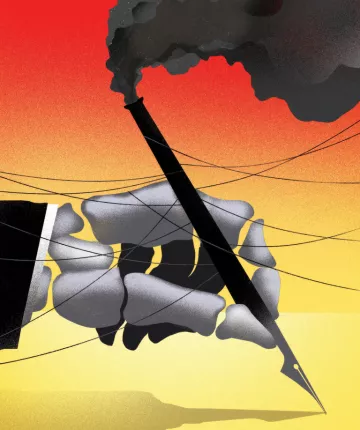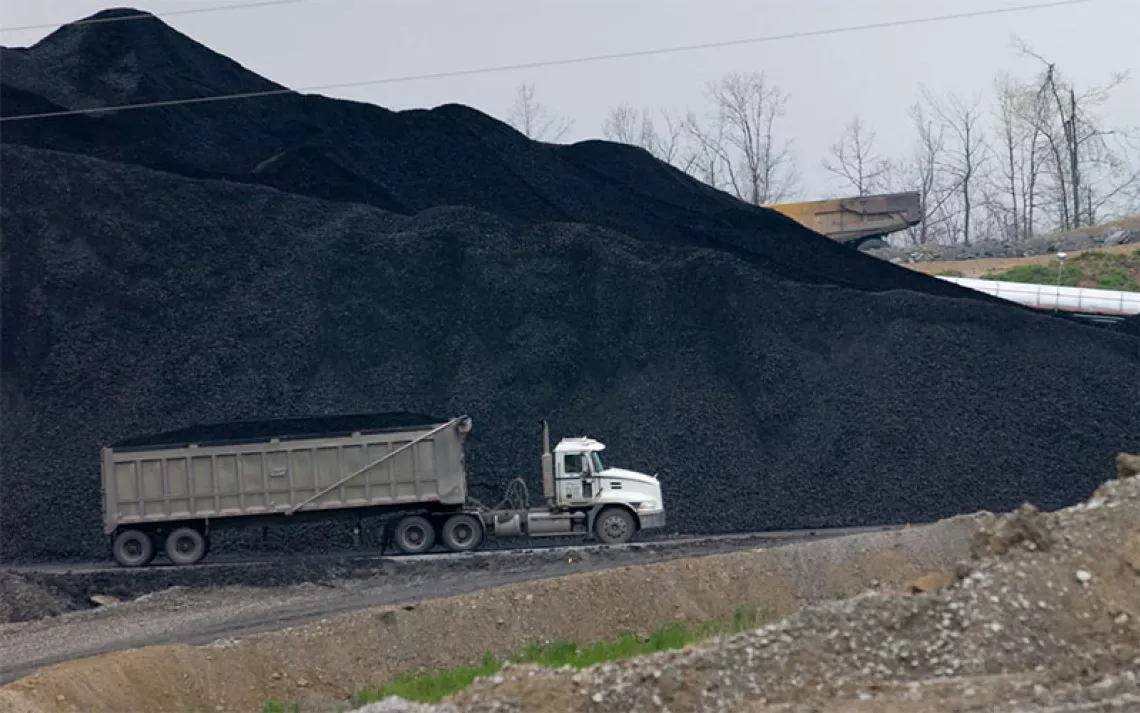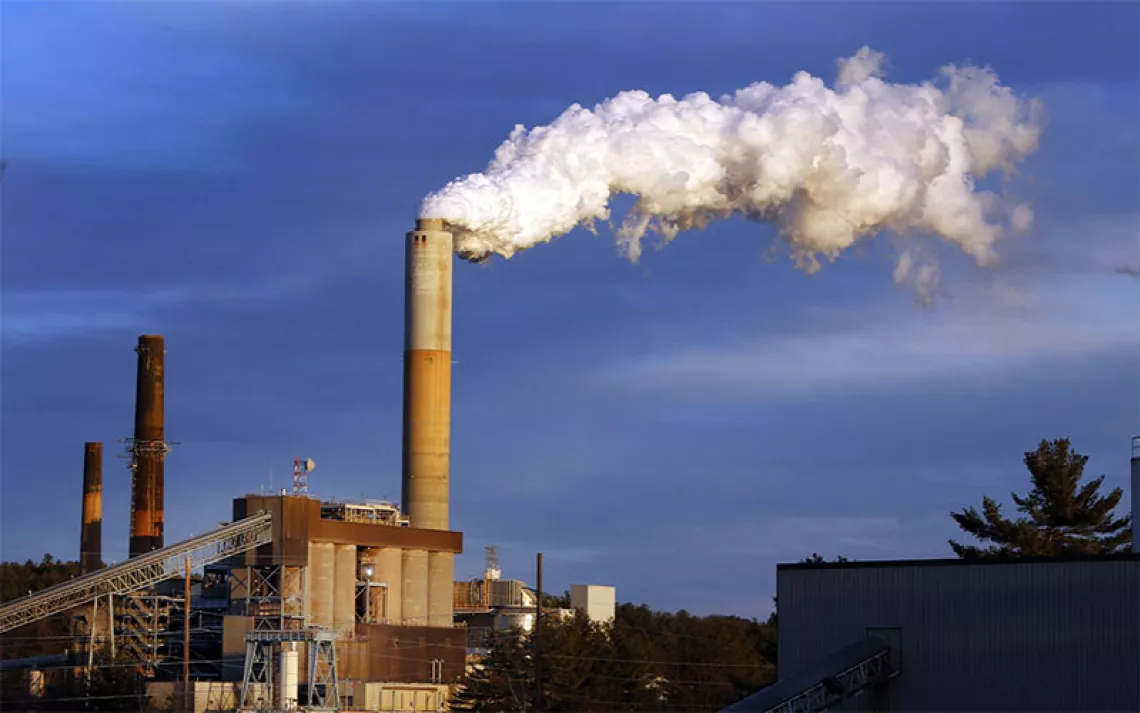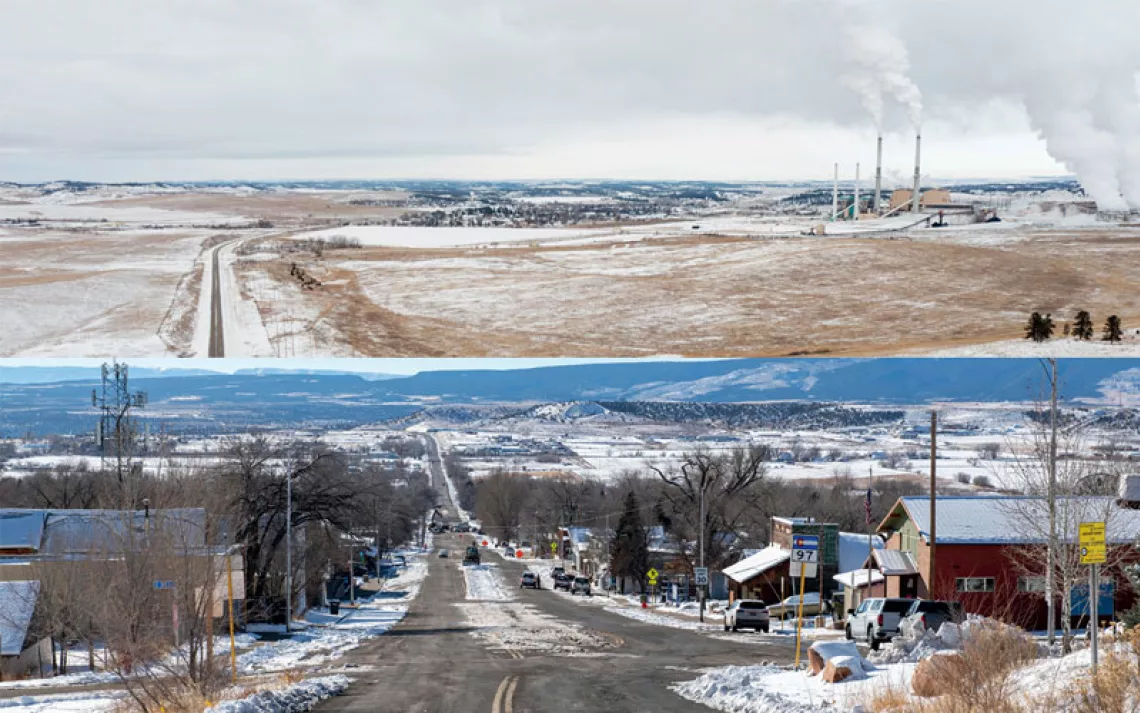Fossil Fuel Ideologues Are Desperate to Keep Coal Alive, No Matter the Costs
Ratepayers and the climate will suffer, but coal's defenders don't seem to care

LAST FEBRUARY, KENTUCKY state senator Robby Mills sat at a long mahogany table during a meeting of the Natural Resources and Energy Committee. His blue pinstripe suit pressed against the state seal imprinted on his chair—two white men, one in buckskin and one in a suit, clasping hands. Mills, a dry cleaner from western Kentucky, was elected to the state legislature in 2016. Decades earlier, he'd graduated from Oral Roberts University, a Christian evangelical school in Tulsa, Oklahoma, and he had brought those conservative beliefs, especially on climate, with him into public office. For months, Mills, who didn't respond to repeated interview requests, had shared Twitter posts by Alex Epstein, author of Fossil Future, a book claiming human flourishing requires the use of more fossil fuels. Days before the meeting, Mills had bragged online about the "300 years worth of coal under our feet!"
Now, gray hair flattened cleanly along his temples, Mills tidied his notes and looked up through clear plastic frames, facing a committee largely friendly to his sponsored legislation: Senate Bill 4, which would make it harder for Kentucky utilities to shut down their old and expensive coal plants. The bill would require electricity providers to go through a complex, time-consuming series of hearings to get permission from state regulators to close fossil fuel generators. In a direct attack on the Inflation Reduction Act, which created $380 billion in federal support for clean energy programs, the bill also required utilities to demonstrate that any proposed coal plant closures weren't the result of federal incentives.

As recently as a decade ago, corporate interests likely would have endorsed Mills's bill. But in February, some of the state's biggest utilities arrived at Kentucky's capitol in opposition to the idea. Just two months earlier, Louisville Gas & Electric and Kentucky Utilities (LG&E/KU) had proposed retiring four coal-burning units, a move that the utility said would save customers $600 million. During the hearing, Kent Blake, vice president of LG&E/KU, begged lawmakers to "stand down" on all energy legislation and asked them to form a stakeholder group that could address affordability and reliability in the long term. He insisted that the federal tax credits for coal retirements could only lead to benefits for ratepayers. Keeping coal units open, he said, would result in "higher rates that put existing industry and economic development in the state at risk."
Sitting beside Blake, Rocco D'Ascenzo, deputy counsel for Duke Energy Kentucky, warned lawmakers that the proposed legislation would force Duke's northern Kentucky customers to underwrite, in perpetuity, the East Bend Station, a 648-megawatt, single-unit generator built in 1981 near the tiny town of Rabbit Hash. In short, customers would pay for the operation and maintenance of a plant no longer producing any energy. "If this bill passes," D'Ascenzo said, "we would not be able to close a fossil fuel plant. That isn't a hyperbole."
Mills was unmoved by the arguments from the state's energy providers.
"Coal has gone beyond being an economic issue to becoming an identity issue in part of the culture wars."
"Senate Bill 4 is designed to ring the bell in Kentucky, and hopefully the nation, and to serve as our initial action to address the coming reliability crisis in electric generation," Mills insisted. Burning fossil fuels was the only way "Grandma and Grandpa can know their medical device has power, and [they] can stay warm." Passing the bill, he continued, would make sure Kentuckians "didn't end up with the issues that happened over Christmas."
He was referring to Winter Storm Elliott, a polar vortex that swelled over the eastern half of the United States like a giant purple bruise the previous holiday season. On the night of December 23, 2022, temperatures in Kentucky plummeted from 45°F to 5°F. High winds arrived in lockstep, whipping freezing rain across the state. To save the electrical grid from total collapse, the Tennessee Valley Authority and LG&E/KU instituted the first rolling blackouts in each of their histories. A subsequent report by the Institute for Energy Economics and Financial Analysis found that more than 100,000 megawatts of coal and gas generation failed to start or went offline during the storm; in comparison, generation from renewables like wind and solar met or exceeded expectations of reliability.
State representative Al Gentry, a fourth-term Democrat and hydrogeologist from Louisville, expressed frustration at the Senate Bill 4 hearing over the lack of discussion about the increasing pattern of extreme weather events in the commonwealth. Winter Storm Elliott was just one event in a growing list of climate-change-intensified disasters. Other freak events included the F4 tornadoes in West Kentucky in 2021 and 2022's historic floods in East Kentucky that, combined, killed 125 Kentuckians. Gentry warned his colleagues that Kentucky's climate was changing. "We're dealing with things we haven't dealt with ever," he said.
Gentry was also concerned that keeping coal plants open would exacerbate the public health issues that had plagued his community for decades. He grew up in a poor corner of southwest Louisville, bookended by a pair of coal plants—Cane Run, which transitioned to methane gas in 2015, and Mill Creek. Gentry remembered that when he was a child, black soot from coal emissions had piled in layers beside houses and on top of cars. "If you could imagine always having to clean that off, you can imagine what lined your lungs," he told me during a phone call. "We had a shorter life expectancy. . . . We had high respiratory issues and cancers. The Clean Air Act was a good thing."
Today, only 11,000 West Virginia residents work in coal, a 90 percent decline from the industry's zenith.
Historically, the price for keeping unprofitable coal plants open has been paid in the impacts to public health. A Sierra Club study released in early 2023 showed that Jefferson County, which encompasses Louisville, had the third-highest rate of premature deaths from coal plant pollution in the United States. Asthma-induced hospital visits in Louisville have declined after coal plant retirements and environmental upgrades, according to a Columbia University study. A trio of Kentucky power plants were responsible for 315 of the nation's 6,700 premature deaths related to coal-fired electricity generation. Senate Bill 4 would likely result in two of those plants, Mill Creek and Ghent, continuing to spew greenhouse gas emissions and dangerous particulate matter past their initial retirement dates.
After Mills formally filed his bill, opposition to his idea kept growing. In March, the Kentucky Association of Manufacturers—which partners with major employers like Brown-Forman, the distiller of Jack Daniel's, and the Chemours Company, the maker of products like Teflon—issued a letter opposing the proposal. The association said Senate Bill 4 would fail to "improve our state's energy security, reliability, or resiliency." Instead, the bill would likely "increase costs for manufacturers, other businesses, and Kentucky consumers."
Despite the pushback from utilities, public health researchers, and industry, Republicans remained steadfast in their support of Mills's proposal.
Jim Gooch, chair of the House Natural Resources and Energy Committee, conceded during a subsequent public meeting that customers "might be required to pay a little more for reliability, but I think that might be very well spent to make sure that when our citizens flip that light switch, those lights are on." Most state lawmakers remained married to the myth that coal plant closures, rather than a lack of investment in renewable replacements, had resulted in an unreliable energy grid.
"Nothing you can say is going to convince us otherwise," Gooch said.
Senate Bill 4 passed the state House and Senate by overwhelming margins. In late March, it passed the governor's desk without his signature.
A DECADE AGO, when coal accounted for roughly 40 percent of the nation's electricity generation, Michael Bloomberg, the former New York City mayor and environmental philanthropist, famously called coal "a dead man walking." (Bloomberg Philanthropies is a Sierra Club funder.) The observation was right. Today, coal supplies less than 20 percent of US electricity, and its share of the energy market is shrinking. The United States is on track to close half its remaining coal facilities by 2026.
There are many forces behind the demise of coal's 150-year-long dynasty. More than a century of mining means coal seams are thinning, making extraction more expensive. Grassroots efforts like the Beyond Coal campaign have succeeded in shutting down hundreds of coal plants nationwide. The Paris Agreement and the Inflation Reduction Act have accelerated the market forces now focused on the clean energy transition. Only one US coal plant—Dry Fork in Wyoming—remains cost-competitive with renewables. Last year in the United States, generation from renewables surpassed that from coal and nuclear.
For people worried about the climate crisis and public health, coal's collapse is demonstrably good news. But it's bad news for the coal industry. Which is why fossil fuel proponents, abetted by coal-friendly legislatures, are doing everything they can to keep coal afloat.
The strategy isn't smart governance. It's not necessarily even smart politics. Utilities and energy experts agree that keeping the coal-fired power plants open endangers the public, increases emissions, and keeps us locked into a more volatile and costlier grid. "Slowing down the transition in certain states is going to lead to higher costs and increased levels of greenhouse gas pollution," said Erin Overturf, a managing attorney at Earthjustice. It could also result in "worse health outcomes for communities around those plants . . . and an increased accumulation of toxic waste like coal ash, which has the potential to contaminate our water and impact our health long after a power plant has stopped generating electricity."
Yet some Republican legislatures are bluntly prioritizing coal interests over those of the ratepayers who elevated them to office. Wyoming was the first state to pass a law making it more difficult to close coal plants. In 2019, lawmakers began requiring electric utilities to request approval from state regulators to retire a plant. North Dakota followed suit in 2021 with a unanimous vote in both houses. In 2023, Kentucky, Indiana, Utah, and West Virginia all passed copycat legislation.
The marionette strings of the coal industry counteroffensive can be traced back to the Texas Public Policy Foundation, an Austin-based conservative think tank that has received at least $4 million from fossil fuel interests like the Koch brothers. (The foundation told Sierra that while it is public knowledge that entities related to the Koch family have made donations, the organization's nonprofit status means it does not disclose specific gifts or donors.) The pro-coal legislation was pushed by Michael J. Nasi, a partner with the Texas-based law firm Jackson Walker LLP and a senior fellow with the project Life:Powered, a Texas Public Policy Foundation initiative to "raise America's energy IQ."
For the better part of a decade, Nasi has crisscrossed the country to expose what he called an "anti-fossil-fuel ideology" during congressional testimony in June. In Wyoming, he represented front groups for the continued purchase of state coal. In Indiana, he testified that coal plays a critical role in the nation's electrical grid. And in 2018, he told Kentucky's Natural Resources and Energy Committee that coal made up almost three-quarters of the total energy needed for a functioning grid.
Brent Bennett, policy director of Life:Powered, told Sierra in an email, "The effort to rapidly eliminate fossil fuels is largely based on ideology and is not consistent with sound science or with policies that promote maximum human flourishing." In a separate email, Nasi said he's been invited to hearings and regulatory proceedings to share concerns that "far too many advocates in the energy policy debate appear to be advocating for the elimination of the use of fossil fuels in a manner that is too often factually untethered to the stated goal of improving human health and the environment." Nasi added that it's "not sustainable to continue to retire thermal-generation assets and replace them with weather-dependent resources" like solar and wind.
But energy market observers say that the arguments being made in favor of propping up coal are outdated and ill-considered.
"Coal has gone beyond being an economic issue to becoming an identity issue in part of the culture wars," said Sean O'Leary, senior researcher with the Ohio River Valley Institute, an Appalachian think tank focused on energy and economic issues. He said the attractiveness of low-cost renewables is causing political fissures in states that had once been solidly in support of coal and in opposition to any resource that might threaten coal. The energy transition is happening, he said, because of raw economics. In Wyoming, for example, wind generation more than doubled in the past four years and in 2021 accounted for almost a fifth of the state's electricity generation.
"The simple fact is wind and solar generation in many places are significantly less expensive—not just from coal but from natural gas," O'Leary said. "It's why Texas, which is a fossil fuel state if there ever was one, now produces more renewable energy than any other state in the nation."
The pro-fossil-fuel campaign driven by the Texas Public Policy Foundation and others presents problems for coal-state lawmakers who are trying to bring attention to the main culprit in extreme weather events—climate change fueled by carbon pollution—and prioritize the safest and most cost-effective solution, which is transitioning from coal generation to clean energy. In the process, fossil fuel ideologues have transformed a dead man walking into a zombie that has proved very difficult to kill.

NO STATE HAS BEEN MORE determined to keep coal on a taxpayer-funded lifeline than Wyoming. The Cowboy State has led the nation's coal production since the 1980s; as recently as 2020, it mined two-fifths of the country's coal. Just behind Texas in net energy production, Wyoming produces 13 times more energy than the rural state uses and earns the majority of state income from exporting the surplus.
But Wyoming's coal economy isn't immune from the vast changes that are underway. In 2019, Wyoming's largest utility, PacifiCorp, which delivers electricity to six western states, issued a report stating that 60 percent of its coal plants were uneconomic. So state legislators swooped in.
During the 2019 legislative session, the Republican supermajority passed Senate File 159, which forced utilities wishing to speed up a coal unit's retirement to first try to sell the facility. During the past four years, Wyoming lawmakers have passed a slate of additional bills seeking to prop up coal. The measures include limiting a utility's cost recovery after retiring a coal plant; forcing regulators to consider grid reliability before approving a retirement; creating a $1.2 million fund for the governor to sue other states if they opt to power themselves with clean energy rather than purchase Wyoming's lignite coal; and establishing the nation's first carbon-capture portfolio standards.
Many of these laws seem like little more than performative politics; so far, their real-life impacts have been negligible. No lawsuit has been filed by the governor against other states, according to Shannon Anderson, attorney and organizer for Powder River Basin Resource Council, a nonprofit working to protect Wyoming residents against the impacts of fossil fuels. A pair of studies showed retrofit costs to install carbon-capture technology would be uneconomical—up to $1 billion per unit.
"It's incredibly unlikely that carbon-capture technology will happen in Wyoming," Anderson said. "The surest way to close a coal plant is to make carbon capture required, because it's going to make it more expensive." She added that there is a growing realization that "it is frankly just too late to save coal."
Meanwhile, West Virginia legislators were engaged in a similar effort to rescue coal as they tried to save the Pleasants Power Station. The 1,300-megawatt coal plant, with three smokestacks and two enormous cooling towers, rises above the Ohio River in Pleasants County, on the state's far western edge. The behemoth started burning coal in 1979, and 40 years later the plant was struggling to remain profitable. In 2019, lawmakers called a special session and issued the plant's then owner, FirstEnergy, a $12.5 million tax break to keep it running.
While FirstEnergy was wrangling funds for fossil fuel plants in West Virginia, the company was filling the pockets of lawmakers in Ohio. In 2020, federal investigators revealed that FirstEnergy had given some $61 million in bribes to Ohio's former House speaker and Republican Party chair for a $1 billion bailout of two nuclear plants. Last March, a federal jury convicted both men of racketeering. While the bailout was overturned, the legislation that sought to protect nuclear energy also included subsidies for two Eisenhower-era coal plants. Those subsidies remain on the books and continue costing Ohio ratepayers $150 million annually.
After the scandal broke, FirstEnergy declared bankruptcy and tried to revamp its image, changing its name to Energy Harbor. The makeover included a promise to become a net-zero carbon emitter. Last spring, the company announced the retirement of two of its coal plants: West Virginia's Pleasants and Ohio's W.H. Sammis.
Jim Justice, West Virginia's Republican governor and a coal baron worth over $500 million, did not want to see Pleasants close. At a press conference in February, Justice said he would do "anything [he] can possibly do" to keep Pleasants running as a coal-fired power plant for "many, many, many years to come." In his pleas, Justice highlighted job losses—the plant is the county's largest employer and taxpayer.
The Ohio River Valley Institute's O'Leary said the perception that coal is central to West Virginia job growth and economic survival is "statistically pure nonsense." Back when coal was the nation's top energy source, political fealty to coal made more sense—one in 10 West Virginians worked in the industry. But once mining became automated and methane gas became competitive, jobs dwindled. Today, only 11,000 state residents work in coal, representing a 90 percent decline from the industry's zenith.
"The only thing not underestimated about coal is its cultural significance," O'Leary said. He grew up in West Virginia, where he listened to choirs on the radio singing "Coal is West Virginia." At West Virginia University, football players still run onto the field past a lump of coal that they rub for good luck before each game.
Governor Justice's arguments may not be accurate, but they're culturally relevant, and they're backed by the utility-regulating Public Service Commission he appointed, where one member is the immediate past president of the West Virginia Coal Association and the chair, Charlotte Lane, is a former FirstEnergy lobbyist. (Lane declined to be interviewed for this story.) Last December, the Public Service Commission issued an order, later backed by a vote in the state legislature, asking two electric utilities to consider purchasing Pleasants from Energy Harbor.
The plant took a break from producing electricity in June, but by late August, it was chugging out carbon again. Pleasants will burn coal until its new owner, California-based Omnis Fuel Technologies, converts the plant to hydrogen. The $800 million investment will create 600 jobs and save the existing 160 jobs at the plant, according to the governor's office, but no timeline for the plant's conversion has been released.
Evan Hansen, a third-term House delegate from north-central West Virginia and one of only 11 Democratic members in the chamber, was one of the few who voted against keeping Pleasants open. Hansen, who also founded Downstream Strategies, an environmental and economic-development consulting firm, advocates for more solar in the state. In 2020, he sponsored a successful utility solar bill that made it easier for electric utilities to develop 200 megawatts of solar each. "Every company considering siting in West Virginia needs access to renewable energy," Hansen said. "That finally got through to state leaders."
West Virginia now has two renewable projects underway. A 200-megawatt microgrid is under construction in Jackson County, and a 120-megawatt wind project will sell half its energy output to Toyota once complete. But instead of working to create even more renewable projects, West Virginia authorized American Electric Power—a utility that's roughly two-thirds fossil fuel powered—to spend whatever it takes to comply with federal environmental regulations and keep its three coal plants open until at least 2040. The decision will cost customers, at minimum, $450 million. Ratepayers are the ones who suffer most, with higher utility rates and less competitive local economies. During the past decade, West Virginia has had some of the fastest-rising utility rates in the nation, which, according to O'Leary, is directly attributable to the state's continued reliance on coal.
"The energy transition really flows through the states, and one thing that really concerns me, apart from the environmental impacts, are the impacts . . . on people," Earthjustice attorney Overturf said. "Continued reliance on fossil fuels is going to create an energy affordability crisis." The biggest holdup to clean energy, she said, is political will. "We have the technology. We know that it works. We just don't have the legal, regulatory, and political systems to support the transition at the pace that it needs to happen."
IN MID-AUGUST, Louisville residents shuffled through the Carnegie-era stone facade of the downtown library for a meeting of the Kentucky Public Service Commission. In a beige conference room, the executive director greeted the crowd promptly at 5:30 p.m., ready to finish the last of five public comment hearings on LG&E/KU's proposed coal retirements. By 2028, the state's largest utility planned to retire 1,500 megawatts of coal power and replace the generation with almost 1,300 megawatts of methane gas and about 1,000 megawatts of solar and battery storage. (Almost 70 percent of the plan's more than $2 billion price tag is the cost of new gas plants. In a press release, utility officials said an all-renewable-energy plan could double the price tag of the current proposal.) The hearings—held in the state's two largest metro areas as well as in West Kentucky and East Kentucky and one virtual—had been required by Senate Bill 4.
At the meeting, more than a dozen people spoke in favor of the planned coal retirements and also against replacing coal with methane gas; only one Louisville resident spoke in favor of the gas expansion. George Perkins, an LG&E/KU customer in Louisville who has rooftop solar, told commissioners that the proposed gas plants—with a life span of up to 50 years—could be required to shut down early as climate change worsens and emissions standards are tightened, leaving the costs stranded on customers. "Although an ill-conceived legislation prevents government subsidies from being considered in a decision to close the coal-fired plants," Perkins said, referring to Senate Bill 4, "LG&E/KU should be encouraged and required to include an analysis of alternatives with credits and incentives that the Inflation Reduction Act offers."
One of the final speakers to stand up at the Louisville hearing was 23-year-old Quincy Robinson. Moving from one polluting source, coal, to another, methane gas, wasn't fair or just, he told commissioners, especially when it could lead to negative health outcomes like asthma, heart problems, and early death. "We must move entirely to renewable energy," he said. "And you must consider the health and well-being of Kentucky citizens."
That plea would seem a more than reasonable request of any public official. In Kentucky, however, elected representatives have long sought to make political gains by prioritizing coal over the protection of the environment and public health. And, in fact, the passage of Senate Bill 4 provided Robby Mills with enough clout to become the running mate of Republican attorney general Daniel Cameron in his bid for governor against Democratic incumbent Andy Beshear. Cameron and Mills are well matched: Both are climate-science deniers and staunchly pro-coal.
But their grasp on what Kentuckians want for their future could be slipping. In November, Cameron and Mills lost the governor's race. The day before, the Public Service Commission ordered LG&E/KU to close two of its four coal units, build a new gas plant in Louisville, and add solar power. Market forces, state regulators, and Kentucky voters have a new, forward-looking vision that marks a major departure from the political playbook of the past. Coal's death rattle doesn't have to signal the end of an energy economy in Kentucky; instead, it could mark the start of a more just one.
This article has been updated since publication.
Communities across the US are suffering from coal dust pollution—and they're asking the EPA to do something about it.
 The Magazine of The Sierra Club
The Magazine of The Sierra Club



